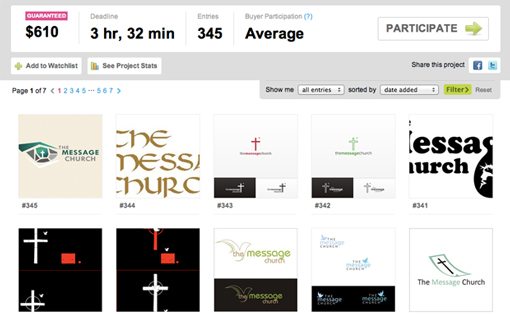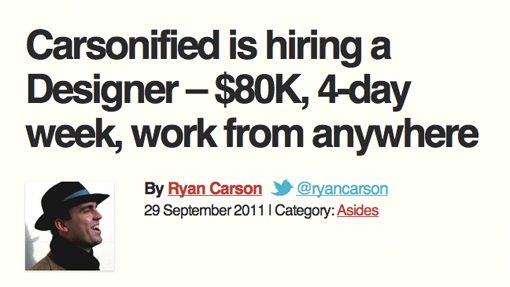Is This Spec Work? Should Designers Be Asked to Prove Their Worth?
Let’s discuss a topic that gets your blood boiling: spec work. What is it and why do designers hate it? This will give us a foundation to discuss some legitimate practices that many are labeling as spec work hiring tactics.
Do you think a designer should be asked to prove himself/herself before being hired? Is this debate an example of employers going too far or designers not willing to go far enough? Let’s find out.
A Little Logic in an Emotional Debate
A few years ago, with the rise of a few web services built on the idea of having designers compete over work, the great spec work war came into being. This time honored tradition of clients scoring work for free or very little was thrust into the light like never before.
Countless designers came to the conclusion that spec work is truly an evil thing aimed directly at ruining the design industry. Many other designers hunkered down and tried to avoid being noticed as they actively and covertly engaged in such activities.
It seems we have grown fairly tired of the debate and moved onto more important topics like whether or not responsive designs are better than fluid designs, but designers are still left with a hot coal in their chest that ignites furiously once again any time they see or hear anything that remotely resembles spec work.
This has resulted in perfectly legitimate practices being openly lashed for joining the dark side and seeking the destruction of designers everywhere. It’s time to calm down, take a step back and analyze what spec work is, why we don’t like it and most importantly, why you should stop freaking out any time someone suggests that a designer must prove his worth.
What Is Spec Work?

We need to start this discussion with a basic definition of terms. This is the most crucial point of the debate as it seems to be the part that is most often misstated.
Speculative work, shortened to “spec work,” refers to the practice of performing work for a client without pay with the hope that they will like it enough to actually purchase it.
Spec work essentially takes the balance of the client/designer relationship and tips the scale entirely in favor of the client. You as the designer are completely at the client’s mercy and are spending valuable time and effort working without pay.
Clients can and do often request several changes, tweaks and redesigns, all without paying for them and without any commitment that they will indeed purchase the work. Too many times, this leads to a designer looking back over hours and hours of wasted time that led to nothing profitable. The whole time the client just stood over them dangling money that they never intended to deliver.
Crowdsourcing
In the case of “crowdsourcing,” there are several designers competing for a single job and are asked to produce a partial or even fully finished version of the design. In the example below, CrowdSpring members enter their competing logo designs into the contest. The winner will be chosen by the client and paid the preset prize money. All other entrants will not be compensated.

The competition here is quite fierce and incredibly underhanded. You can almost always find a talented designer who submitted a truly original idea that the client showed interested in, who is then ripped off directly by other competitors who make good on someone else’s concept and creativity.
There are definitely plenty of legitimate players in crowd sourcing competitions but rest assured that the real bottom feeders find a very happy home here. CrowsdSpring and others could fix much of this by simply not allowing an entrant to see the work of others, but since they directly benefit from this shady activity, they let it go on.
The Kicker: It’s Real Work
The interesting distinction to note here is that this is real work. It is not a sample project meant to showcase a designer’s strengths and weaknesses, it’s the client possessing and utilizing an unfair amount of leverage over the designer so that their own terms are met.
The ultimate result can’t be anything but underpaid labor. As a staunch free market capitalist I firmly believe in competition but this is not “healthy” competition. A row of restaurants on the same street is healthy competition. This is akin to those restaurants being forced to give their food away free to every passerby while being rarely paid and even then at a price completely at the discretion of the eater.
Another important thing to note is that much spec work is focused on the product, not the designer. You’re not being evaluated for your skill, you’re not earning your way into a promising career, you’re merely a salesman trying to peddle your custom-built wares. Even if the client purchases it, the relationship often ceases there.
Carsonified: Design Something & Win a Job!
I’ve written about Carsonified and Think Vitamin founder Ryan Carson’s hiring practices before. I see this company as an innovative leader in a new world where fluffed up paper resumes mean nothing in light of actual talent. In fact, when Think Vitamin and/or Carsonified is hiring, they have a strict policy against resumes. They simply don’t want to see them!

Ryan Carson and his gang are at it again. Earlier this month they posted a job opening on their blog. The position is for a remote full-time designer at a whopping $80,000 per year. To sweeten the deal even further, Think Vitamin employees work 9am-6pm four days per week while getting paid for a five day workweek! If you think this sounds like a dream job, you’re right, it is.
Without a resume to go from, how is Carsonified going to choose a candidate for a dream job? Via a competition! They gave designers a sample project by asking them to design a dashboard for their life and gave some specific parameters for what has to be included. The designer with the best design gets the job.
Revolt Via Comments

It wasn’t long before some designers started to look at this with a suspicious eye. In fact, the comment section of the post quickly filled with outrage and indignation.
Isn’t this spec work? How could a company with such a good reputation be engaging in such an outright evil practice? We expect more from you Carsonified! On and on it goes.
I can easily see where the confusion lies. This admittedly sort of feels no different from CrowdSpring right? A bunch of designers are spending time and effort on work that they won’t get paid for, only one of which will get anything in return. Grab your pitchforks boys, it’s time to kill this monster.
Not so fast though, these conclusions are in reality way off base. When in doubt about whether something is or isn’t spec work, check the motives of the client. Are they attempting to score some work for free or illegitimately drive down the price of labor?
The answer is a firm and resounding “no.” This project to be worked upon is merely a sample. Carsonified didn’t ask entrants to give them a free new design for their site. They made something up so designers could showcase their talent. The bottom line is, Carsonified doesn’t really benefit from getting cheap design labor!
Further, not only are they not driving down the cost of design work, they’re actually offering up a job with a dang good starting salary and some unbeatable perks.
A Singing Competition

One of the more interesting arguments in the Carsonified job comments related to whether or not it’s a good thing to hire people for design work like you’re choosing contestants in a singing competition. This is an interesting metaphor that’s worth exploring.
The thing to remember is that when you hire a designer, you’re someone hiring for a creative position. The success of this person at your company depends largely upon whether or not they can do the kind of work you want them to. Resumes are notoriously bad predictors of this type of success. Who cares where you went to school or even where you worked before? What matters is whether or not you can design what needs to be designed. Even past work portfolios prove to be a poor indicator of current skill. Many designers are far better than their portfolios give them credit for, others are far worse.
The singing metaphor works. If you were going to hire a singer for your band, odds are you wouldn’t ask to see a resume. Instead you’d hand the person a microphone and ask them to sing! There’s after all only one way to judge a singer: letting them sing. Doesn’t it make sense then that the best way to judge designers is by letting them sing? Isn’t the true value of someone’s creative talent best assessed by simply letting them show off?
This can be carried over to countless other fields. Would you hire a public speaker without hearing them speak or a dancer without seeing them dance? Even my wife, a teacher, has to go in and teach a real class while being observed before being considered for a position.
Why Are Designers Better Than Everyone Else?
Back to the singing competition. If this was indeed how you were trying out potential band members, would the entrants have the right to be indignant? What if one of them said that you had no right to hear them sing before you agreed to make them your band leader? Would you laugh them off the stage? Of course you would!
Somehow designers are better though. For whatever reason, our time is worth more than the singer’s and we shouldn’t have to stoop down to the level of proving our talent. The world of potential clients should look at our resumes and portfolios without a doubt as to the authenticity of either. After all, no designer has ever claimed work that wasn’t his own or made himself look a little better on paper than in reality! We should be hired without question, without proving ourselves. Why? Because spec work is evil!
Do you see how little sense this makes? I wish this argument were hyperbole, but it’s not. Unfortunately, it’s exactly how a large part of the design community seems to feel about itself.
Underlying this of course is a strong sense of insecurity. Some commenters actually went so far as to say that it wasn’t worth their time to enter because they never win these types of things. As if that’s the fault of the potential employer! If I as a designer never stand out from the crowd enough to be chosen as the best, then odds are I’m a pretty average designer.
Know Your Roots
What many web designers don’t know is that this is how the design industry has operated for decades, long before they ever came onto the scene. And in continues to operate that way today.
Let’s say a big company like Johnson & Johnson wants to hire a new company to redesign their brand image. Do you think they start looking at resumes? Nope, instead what they do is put out an “RFP” or a “Request for Proposal.” This outlines essentially what they want and how to apply.
Top name firms like BBDO and Chiat Day see that Johnson & Johnson put out the RFP and go into overdrive. There’s a lot of potential work at stake here so everyone whips up some fancy early stage concepts. These concepts almost never represent what will finally be delivered and are more of a statement of “here’s what we’re capable of producing.” The biggest part of the proposal is often not even the creative but the bid that says how much you’ll do the work for. The agency with the combination of the best work and most affordable bid wins, the others go back to their existing clients and discuss how to do better next time.
Unlike CrowdSpring, bidders are blind. They can’t see and ripoff the work of other agencies nor can they offer up a number that they know is lower than their competitor’s. They can only give it their best and hope that they’re good enough.
What’s really crazy is that Johnson & Johnson may do this even if they already have an agency, and they’ll allow that agency to enter! Every few years that design team has to re-prove itself in order to keep the business by beating out the competition yet again.
I’m not saying that every individual designer should be hired in such a way, they shouldn’t. However, before critiquing what you think to be a new fad bent on ruining the design industry, it’s worth knowing your history and how somewhat similar practices actually built an age where being a “graphic designer” was a great job.
Conclusion
This discussion is meant to get you to question your short fuse when it comes to anything that seems related to spec work. It’s meant to help you tell the difference between clients who want to take advantage of designers and good companies like Carsonified who’re offering up great opportunities to those willing to prove themselves. Finally, it’s meant to reign in the notion that designers are somehow more important than every other person in every other creative profession where you actually have to show that you’re good at something before being paid to do it.
I’m confident that many of you reading this are nodding your heads in agreement while plenty of others are fuming. Feel free to keep the debate going in the comments below. How do you feel about the Carsonified contest? Do you really believe it’s an underhanded and seedy tactic aimed at screwing designers over or is it a decent alternative to tired resume-based practices?